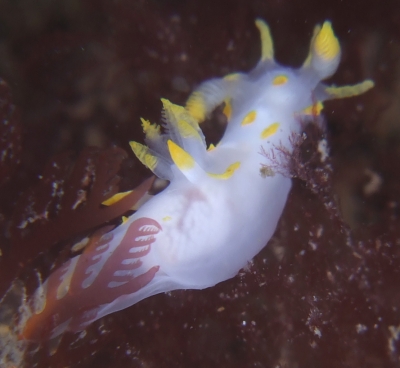Re: Ancula gibbosa from Scotland
June 14, 2006
From: Jim Anderson

Concerning message #16821; #16863:
Dear Bill and Marina,
Thank you for the update and correction. I attach the 3 original jpegs
at the max resolution - perhaps these will assist.
By the way what are the significant ID characteristics between A. gibbosa and Polycera quadricolor? I don't think it is P. faeroensis
Regards,
Jim A
jander4454@gmail.com
Anderson, J., 2006 (Jun 14) Re: Ancula gibbosa from Scotland. [Message in] Sea Slug Forum. Australian Museum, Sydney. Available from http://www.seaslugforum.net/find/16871Dear Jim,
I only need to post your third photo, which you didn't send with your first message. Fortunately it solves the identity problem.
As to separating the three species. There are many internal anatomical differences between species of Ancula and species of Polycera, and fortunately there are a few external ones as well. Firstly, in species of Polycera, there is an extension of the mantle edge into an 'oral veil' over the head, at the anterior end. The edge of this oral veil has a number of tentacular processes which point out horizontally and are arranged in equal numbers on each side of the midline. Species of Polycera usually have a single lateral process alongside each gill, but this is not always a clear distinction, because related polycerids may have a number of processes alongside the gills.
In Ancula, their is no oral veil, there are two forward facing tentacular processes arising from the base of each rhinophore, and their are a number of lateral processes arranged on each side of the body, alongise and just behind the gills. Bernard Picton has sent in a nice photo [message #3910] of a yellow patterned example of Ancula gibbosa from Britain. The simplest difference from polycerids is the lack of an oral veil so the head is clearly visible from above.
In you two earlier photos the oral veil was not visible as the anterior end of the animal was facing down. Fortunately your photo here shows the oral veil quite clearly so we can be sure it is a Polycera. It is possible to distinguish P. quadrilineata from P. faeroensis, by using external characters but as both species are quite variable in colour, most of the colour pattern is not that useful. However the best distinction is that P. quadrilineata usually has 4 (rarely 6) oral veil processes, while P. faeroensis usually has 8 or more. As you animal has 4 long oral veil processes I am pretty sure it is P. quadrilineata.
Best wishes,
Bill Rudman
Related messages
-
Re: Thecacera? or Polycera? species - From Ratnagiri, India
From: Vishal Bhave, May 11, 2009 -
Polycera quadrilineata and bryozoans
From: Joao Pedro Tojal Loia Soares Silva, April 24, 2008 -
Re: Ancula gibbosa from Scotland
From: Jim Anderson, June 15, 2006 -
Re: Ancula gibbosa from Scotland
From: Marina P. Ossokine, June 14, 2006 -
Ancula gibbosa from Scotland
From: Jim Anderson, June 12, 2006 -
Polycera quadrilineata or Trapania tartanella ?
From: Stephane Ores, June 8, 2006 -
Polycera quadrilineata from Portugal
From: Joao Pedro Silva, March 2, 2004 -
Polycera quadrilineata from Turkey
From: Ferda Buyukbaykal, August 23, 2003 -
Polycera quadrilineata from northern Spain
From: Ricardo Roberto Fernández, July 12, 2003 -
Polycera quadrilineata from Turkey
From: Haluk Akbatur, May 29, 2003 -
Re: Unknown dorid from French Brittany
From: Juan Lucas Cervera, September 23, 2002 -
Re: Unknown dorid from French Brittany
From: Bernard Picton, September 23, 2002 -
Unknown dorid from French Brittany
From: Marina Poddubetskaia, September 18, 2002 -
Polycera quadrilineata from French Brittany
From: Marina Poddubetskaia, September 3, 2002 -
Polycera quadrilineata from France
From: Marina Poddubetskaia, July 23, 2002 -
Re: Polycera quadrilineata
From: Jean-Pierre Bielecki, June 20, 2002 -
Re: P. quadrilineata or P. aurantiomarginata?
From: Juan Lucas Cervera, June 19, 2002 -
Polycera quadrilineata or P. aurantiomarginata?
From: J-P. Bielecki , June 18, 2002 -
Re: Polycera aurantiomarginata? from Turkey
From: Juan Lucas Cervera, June 18, 2002 -
Re: Polycera aurantiomarginata from Turkey (2)
From: Lucas Cervera , June 18, 2002 -
Polycera aurantiomarginata? from Turkey
From: Baki Yokes, June 16, 2002 -
Larvae of Polycera quadrilineata
From: Nick Hudson, October 27, 2001 -
Polycera quadrilineata from Holland
From: Peter van Bragt, August 6, 1999 -
Polycera quadrilineata from Wales
From: Daniel Geiger, August 5, 1999
